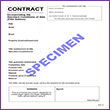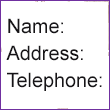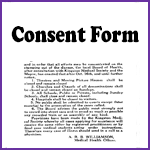The TA7 Leasehold Information Form, drafted by the Law Society, is completed by the seller of a leasehold property, in addition to the:
Sellers need to complete these documents and return them to their solicitor at the first stage of the
conveyancing process. In addition to the TA7 Leasehold Information Form, a seller needs to also get their Freeholder / Managing Agent to complete an LPE1 form; this is called the Leasehold Information Pack. Click to read our simple guide on the
Leasehold Information Pack.
Provide as much information as possible
The more information that is provided within the TA7 form and accompanying documents the better as missing information can cause more problems when the buyer's solicitor
raises legal enquiries.
The Law Society recommends that a seller should complete this form as fully as possible, taking advice from their solicitor, and should inform their solicitor if new information comes to light as matters progress.
False information or omission of facts which could demonstrably have been included also open the prospect of a buyer suing a seller if the former can prove any losses resulting.
Your instructed solicitor should send you this to be completed.
This article considers each of the subjects addressed by the leasehold information form in turn; for speed, you can access any section you find of interest by clicking on the appropriate link here:
Subjects addressed by the leasehold information form
The leasehold information form then covers 10 separate subjects with questions to be answered by the seller.
NB You can, if you need to, use separate pieces of paper to provide further information for evidence to accompany answers to any question on the form.
The 10 sections are:

1 The Property
You need to indicate here whether your property is a house or flat and whether it is shared ownership (click on the link for more information about this).
For most leases you have to pay a
ground rent to the freeholder; you have to put here how much this is and how often it’s payable.

2 Relevant Documents
You are asked to provide a wide range of documents here.
This includes everything which concerns the lease (the agreement, supplemental deeds, additional regulations circulated by landlord/tenants’ management company, any correspondence with landlord, managing company, managing agent, and regarding maintenance,
service charges and
ground rent charges: invoices, demands for payments, statements and receipts).
You have to give a copy of the buildings insurance policy, whether this is arranged by you or the landlord/management company and either a receipt for the last payment (from you, if you organised it) or a schedule (if organised by landlord/management company).
If tenants have formed a management company, you have to supply: Memorandum and Articles of Association, share or membership certificate and the company accounts for the past 3 years.
If you are unsure about any of the documents mentioned in this section or about how to obtain them, your conveyancing solicitor can help you as they have to make sure these documents are produced as part of their ‘Enquiries of the Landlord’ standard conveyancing procedure.
NB These documents are often collectively referred to as the ‘
Management Information Pack’: because they are always required in a sale, the management company/managing agent/landlord should be able to provide them after being given notice to do so. The pack is also known as the
Leasehold Information Pack (click to find out more).
You should normally expect to have to pay anything between £100 to around £300 for these and can find this figure out by making an enquiry to your landlord/managing agent/management company.

3 – Management of the Building
This section ascertains whether your landlord gets a managing agent to collect rent or manage the building. If you pay services charges to anyone other than the landlord or management company, then this will normally be a managing agent.
You are asked whether a management company formed by the tenants has been dissolved or struck off by Companies House: you would most likely know about this.
Tenants form management companies sometimes – and have the right to – if the landlord is failing in their duties but they (the tenants’ management company) can be struck off if the business fails.
You are also asked if tenants have passed responsibility for managing the building day to day to a managing agent.
How do tenants form a management company?
Tenants are allowed to form their own leasehold management company, replacing one originally put in place by the block freeholder.
The process of doing so is known as the
Right to Manage process (click to find out more) and involves a statutorily set procedure.

4 – Contact Details
You have to provide details about who your landlord is. You will normally have correspondence from them to help you with this.
Having the managing agent’s details is sufficient because they can give the landlord’s details to your conveyancer. If you are sharing ownership of the freehold with others, you have to give yours and the other owners/s details.

5 – Maintenance and Service Charges
This section mainly concerns whether you have to pay service charges to maintain the outside and communal areas of the building. If you do have to, then you are asked whether you know about any expenses to come, whether there has been any problems about the level of service charges in the last 3 years and if you have challenged the service charge or any expense in the last 3 years.
A landlord has to serve a ‘
Section 20’ notice before carrying out
major works to a building. If you have received one of these you should disclose it here and include a copy.
If you’ve not received such a notice but are aware that major works may be necessary (perhaps a part of the building has been damaged for example), you should also include details here.
You are also asked if you know whether there’s been any difficulty in collecting the service charges from other tenants and whether you personally are still owing any service charges, rent, insurance premium or other relevant payment.

6 – Notices
This section concerns whether you’ve been informed by the landlord that they wish to sell the freehold, which gives you the option of purchasing it.

7 – Consents
This concerns whether the landlord has informed you about any coming changes or variations to the lease and whether you’ve been given any consents under the lease. A consent is where you’ve asked the landlord if you can do something with/to your property, such as decorate or extend it.
You need to be able to produce paperwork regarding these matters or, if there was no agreement on paper, you need to see if you can get this from the landlord.

8 – Complaints
You are asked if you’ve received any complaints from your landlord, management company or any neighbour regarding anything you have or haven’t done.
You are also asked if you in turn have complained or had cause to complain about landlord/management company/neighbours and are asked to give details if so.
You should include details of any resolved complaints and even complaints you felt were unjustified. Normally, complaints would be in respect of things like noise, pets or littering but could be about anything.

9 – Alterations
The question about whether any alterations have occurred concerns your/the seller’s property and not any other flat/dwelling in the block.
Because the landlord’s consent is normally required for any alterations, you are asked to provide proof of it. If you don’t have it, you should contact the landlord for a duplicate of the documented proof.
If no consent was sought, you should speak to your conveyancer first before speaking to the landlord.

10 – Enfranchisement
You are then asked whether you’ve served a formal notice to the landlord to extend the lease or buy the freehold (along with other tenants) or are aware of other tenants doing so and to provide documentary evidence.
There is, of course, an informal route (explained in the following linked article in the context of
leasehold extensions) - you should still give information if you’ve applied for a lease extension or to buy the freehold informally.
If you are aware of any response from the landlord to any of these requests, you should also provide details.
Fixed Fee – No Sale No Fee – CQS Solicitors


















